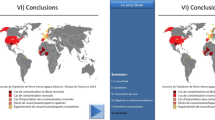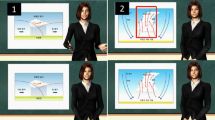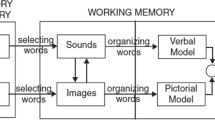Abstract
The purpose of this study was to investigate the effects of different types of cues and self-explanation prompts in instructional videos on intrinsic motivation, learning engagement, learning outcomes, and cognitive load, which were indicators to measure deep learning performance. Seventy-two college students were randomly assigned to one of the six conditions in a 3 × 2 factorial design with cues (visual vs. textual vs. combined textual-&-visual) and self-explanation prompts (prediction vs. reflection) as the between-subjects factors. To measure participants’ learning engagement, Neurosky mindwave mobile and Tobii pro X3-120 eye-tracker were used to collect their brain wave data and eye movement data, respectively. Learning outcomes were measured with retention and transfer tests, and questionnaires were used to measure participants’ intrinsic motivation and cognitive load, respectively. The results revealed that the textual cues significantly facilitated learning outcomes and learning engagement—attention–while the reflection prompts significantly affected learning engagement—the mean fixation duration—and cognitive load. Notably, the combination of textual cues and reflection prompts and the combination of visual cues and prediction prompts allowed the participants to focus and engage in the video learning process more deeply, resulting in a significantly higher learning outcome than their peers from other conditions. This research could provide some implications for designing short instructional videos to facilitate deep learning.







Similar content being viewed by others
Data Availability
The authors declare that data associated with this paper will be made available upon reasonable request.
References
Aguiar-Castillo, L., Clavijo-Rodriguez, A., Hernández-López, L., De Saa-Pérez, P., & Pérez-Jiménez, R. (2021). Gamification and deep learning approaches in higher education. Journal of Hospitality, Leisure, Sport & Tourism Education, 29, 100290. https://doi.org/10.1016/j.jhlste.2020.100290
Akyol, Z., & Garrison, D. R. (2011). Assessing metacognition in an online community of inquiry. The Internet and Higher Education, 14(3), 183–190.
Arslan, I. (2013). Examining the effects of cueing and prior knowledge on learning, mental effort, and study time in a complex animation (Doctoral dissertation). Texas Tech University.
Arslan-Ari, I., Crooks, S. M., & Ari, F. (2020). How much cueing Is Needed in instructional animations? The role of prior knowledge. Journal of Science Education and Technology, 29(5), 666–676.
Atkinson, R. K., Renkl, A., & Merrill, M. M. (2003). Transitioning from studying examples to solving problems: Effects of self-explanation prompts and fading worked-out steps. Journal of Educational Psychology, 95(4), 774–783. https://doi.org/10.1037/0022-0663.95.4.774
Baceviciute, S., Terkildsen, T., & Makransky, G. (2021). Remediating learning from non-immersive to immersive media: Using EEG to investigate the effects of environmental embeddedness on reading in Virtual Reality. Computers & Education, 164(4), 104122.
Baeten, M., Kyndt, E., Struyven, K., & Dochy, F. (2010). Using student-centred learning environments to stimulate deep approaches to learning: Factors encouraging or discouraging their effectiveness. Educational Research Review, 5(3), 243–260.
Bakeman, R., & Gottman, J. M. (1997). Observing interaction: An introduction to sequential analysis. Cambridge University Press.
Bayraktar, D. M., & Bayram, S. (2019). Effects of cueing and signalling on change blindness in multimedia learning environment. World Journal on Educational Technology: Current Issues, 11(1), 128–139.
Biggs, J. (1993). What do inventories of students’ learning processes really measure? A theoretical review and clarification. British Journal of Educational Psychology, 63(1), 3–19.
Bisra, K., Liu, Q., Nesbit, J. C., Salimi, F., & Winne, P. H. (2018). Inducing self-explanation: A meta-analysis. Educational Psychology Review, 30(3), 1–23.
Boucheix, J. M., & Lowe, R. K. (2010). An eye tracking comparison of external pointing cues and internal continuous cues in learning with complex animations. Learning & Instruction, 20(2), 123–135.
Brasel, S. A., & Gips, J. (2017). Media multitasking: How visual cues affect switching behavior. Computers in Human Behavior, 77(12), 258–265.
Canham, M., & Hegarty, M. (2010). Effects of knowledge and display design on comprehension of complex graphics. Learning and Instruction, 20(2), 155–166.
Chen, C. H. (2020). Impacts of augmented reality and a digital game on students’ science learning with reflection prompts in multimedia learning. Educational Technology Research and Development, 68(6), 3057–3076.
Chen, I. S. (2017). Computer self-efficacy, learning performance, and the mediating role of learning engagement. Computers in Human Behavior, 72(7), 362–370.
Chen, W., Allen, C., & Jonassen, D. (2018). Deeper learning in collaborative concept mapping: A mixed methods study of conflict resolution. Computers in Human Behavior, 87(10), 424–435.
Chi, M. T. H. (2000). Self-explaining expository tests: The dual process of generating inferences and repairing mental models. In R. Glaser (Ed.), Advances in instructional psychology (pp. 161–238). Lawrence Erlbaum Associates.
Chi, M. T., Bassok, M., Lewis, M. W., Reimann, P., & Glaser, R. (1989). Self-explanations: How students study and use examples in learning to solve problems. Cognitive Science, 13(2), 145–182. https://doi.org/10.1016/0364-0213(89)90002-5
Chi, M. T., De Leeuw, N., Chiu, M. H., & LaVancher, C. (1994). Eliciting self-explanations improves understanding. Cognitive Science, 18(3), 439–477. https://doi.org/10.1016/0364-0213(94)90016-7
De Koning, B., Tabbers, H., Rikers, R., & Paas, F. (2009). Towards a framework for attention cueing in instructional animations: Guidelines for research and design. Educational Psychology Review, 21(2), 113–140.
De Koning, B., Tabbers, H. K., Rikers, R. M. J. P., & Paas, F. (2010). Learning by generating vs. receiving instructional explanations: Two approaches to enhance attention cueing animations. Computers & Education, 55(2), 681–691.
De Koning, B., Tabbers, H. K., Rikers, R. M. J. P., & Paas, F. (2011). Attention cueing in an animation: The role of presentation speed. Computers in Human Behavior, 27(1), 41–45.
Dubovi, I. (2022). Cognitive and emotional engagement while learning with VR: The perspective of multimodal methodology. Computers & Education, 183, 104495. https://doi.org/10.1016/j.compedu.2022.104495
Filius, R. M., Kleijn, R., Uijl, S. G., Prins, F. J., Van, R., & Grobbee, D. E. (2018). Strengthening dialogic peer feedback aiming for deep learning in spocs. Computers & Education, 125(10), 86–100.
Fonseca, B. A., & Chi, M. T. (2011). The self-explanation effect: A constructive learning activity. In R. Mayer & P. Alexander (Eds.), Handbook of research on learning and instruction (pp. 270–321). Routeledge Press.
Gerjets, P., Scheiter, K., & Catrambone, R. (2006). Can learning from molar and modular worked examples be enhanced by providing instructional explanations and prompting self-explanations? Learning & Instruction, 16(2), 104–121.
Grover, S., Pea, R., & Cooper, S. (2015). Designing for deeper learning in a blended computer science course for middle school students. Computer Science Education, 25(2), 199–237.
Hajian, S., Jain, M., Liu, A. L., Obaid, T., Fukuda, M., Winne, P. H., & Nesbit, J. C. (2021). Enhancing scientific discovery learning by just-in-time prompts in a simulation-assisted inquiry environment. European Journal of Educational Research, 10(1), 989–1007. https://doi.org/10.12973/eu-jer.10.2.989
Hart, S. G., & Staveland, L. E. (1988). Development of NASA-TLX (Task Load Index): Results of empirical and theoretical research. Advances in Psychology (Vol. 52, pp. 139–183). North-Holland.
Hegarty, M., Kriz, S., & Cate, C. (2003). The roles of mental animations and external animations in understanding mechanical systems. Cognition and Instruction, 21(4), 209–249. https://doi.org/10.1207/s1532690xci2104_1
Hou, H. T., Sung, Y. T., & Chang, K. E. (2009). Exploring the behavioral patterns of an online knowledge-sharing discussion activity among teachers with problem-solving strategy. Teaching and Teacher Education, 25(1), 101–108.
Hung, I. C., Yang, X. J., Fang, W. C., Hwang, G. J., & Chen, N. S. (2014). A context-aware video prompt approach to improving students’ in-field reflection levels. Computers & Education, 70, 80–91.
Johnson, A. M., Ozogul, G., & Reisslein, M. (2015). Supporting multimedia learning with visual signaling and animated pedagogical agent: Moderating effects of prior knowledge. Journal of Computer Assisted Learning, 31(2), 97–115.
Juliane, R., Katharina, S., & Alexander, A. (2016). Signaling text-picture relations in multimedia learning: A comprehensive meta-analysis. Educational Research Review, 17(2), 19–36.
Kaakinen, J. K. (2021). What can eye movements tell us about visual perception processes in classroom contexts? Commentary on a special issue. Educational Psychology Review, 33(1), 169–179.
Koszalka, T. A., Pavlov, Y., & Wu, Y. (2021). The informed use of pre-work activities in collaborative asynchronous online discussions: The exploration of idea exchange, content focus, and deep learning. Computers & Education, 161, 104067.
Kriz, S., & Hegarty, M. (2007). Top-down and bottom-up influences on learning from animations. International Journal of Human-Computer Studies, 65(11), 911–930.
Lei, H., Cui, Y., & Zhou, W. (2018). Relationships between student engagement and academic achievement: A meta-analysis. Social Behavior and Personality: An International Journal, 46(3), 517–528.
Lin, L., & Atkinson, R. K. (2011). Using animations and visual cueing to support learning of scientific concepts and processes. Computers & Education, 56(3), 650–658. https://doi.org/10.1016/j.compedu.2010.10.007
Lin, L., Atkinson, R. K., Savenye, W. C., & Nelson, B. C. (2016). Effects of visual cues and self-explanation prompts: Empirical evidence in a multimedia environment. Interactive Learning Environments, 24(4), 799–813.
Liu, Z., Zhang, Y., & Zhou, P. (2022). Research on the influence of self-efficacy on learning outcomes in desktop virtual reality environment: The mediating based on flow experience. Journal of Distance Education (in Chinese), 4, 55–64. https://doi.org/10.15881/j.cnki.cn33-1304/g4.2022.04.005
Lu, K., Pang, F., & Shadiev, R. (2021). Understanding the mediating effect of learning approach between learning factors and higher order thinking skills in collaborative inquiry-based learning. Educational Technology Research and Development, 69(5), 2475–2492.
Marton, F., & Säljö, R. (1976). On qualitative differences in learning: I—Outcome and process. British Journal of Educational Psychology, 46, 4–11. https://doi.org/10.1111/j.2044-8279.1976.tb02980.x
Mautone, P. D., & Mayer, R. E. (2001). Signaling as a cognitive guide in multimedia learning. Journal of Educational Psychology, 93(2), 377–329. https://doi.org/10.1037/0022-0663.93.2.377
Mayer, R. E. (2009). Multimedia learning (2nd ed.). Cambridge University Press.
Mayer, R. E. (2014). Cognitive theory of multimedia learning. The Cambridge handbook of multimedia learning (2nd ed., pp. 43–71). Cambridge University Press.
Merrill, M. D. (2012). Instructional transaction theory: An instructional design model based on knowledge objects. Instructional Design: International Perspectives: Volume I: Theory, Research, and Models: volume Ii: Solving Instructional Design Problems, 381.
Miller, B. W. (2015). Using reading times and eye movements to measure cognitive engagement. Educational Psychologist, 50(1), 31–42.
Miller, R. E., Strickland, C., & Fogerty, D. (2018). Multimodal recognition of interrupted speech: Benefit from text and visual speech cues. The Journal of the Acoustical Society of America, 144(3), 1800–1800.
Moreno, R., & Mayer, R. (2007). Interactive multimodal learning environments. Educational Psychology Review, 19(3), 309–326.
Moreno, R., & Mayer, R. (2010). Techniques that increase generative processing in multimedia learning: Open questions for cognitive load research. In J. Plass, R. Moreno, & R. Brünken (Eds.), Cognitive load theory (pp. 153–177). Cambridge University Press.
Nokes, T. J., Hausmann, R. G., VanLehn, K., & Gershman, S. (2011). Testing the instructional fit hypothesis: The case of self-explanation prompts. Instructional Science, 39(5), 645–666. https://doi.org/10.1007/s11251-010-9151-4
Offir, B., Lev, Y., & Bezalel, R. (2008). Surface and deep learning processes in distance education: Synchronous versus asynchronous systems. Computers & Education, 51(3), 1172–1183.
Ozcelik, E., Karakus, T., Kursun, E., & Cagiltay, K. (2009). An eye-tracking study of how color coding affects multimedia learning. Computers & Education, 53(2), 445–453.
Park, J., Park, C., Jung, H., & Kim, D. (2020). Promoting case indexing in case library learning: Effects of indexing prompts on self-explanation and problem solving. Journal of Computer Assisted Learning, 36(5), 656–671.
Plass, J. L., Heidig, S., Hayward, E. O., Homer, B. D., & Um, E. (2014). Emotional design in multimedia learning: Effects of shape and color on affect and learning. Learning and Instruction, 29, 128–140.
Ponce, H. R., & Mayer, R. E. (2014). An eye movement analysis of highlighting and graphic organizer study aids for learning from expository text. Computers in Human Behavior, 41, 21–32.
Roy, M., & Chi, M. T. H. (2005). The self-explanation principle in multimedia learning. In R. E. Mayer (Ed.), The Cambridge handbook of multimedia learning (pp. 271–286). Cambridge University Press.
Ryan, R. M. (1982). Control and information in the intrapersonal sphere: An extension of cognitive evaluation theory. Journal of Personality and Social Psychology, 43(3), 450–461. https://doi.org/10.1037/0022-3514.43.3.450
Schneider, S., Beege, M., Nebel, S., & Rey, G. D. (2018). A meta-analysis of how signaling affects learning with media. Educational Research Review, 23, 1–24. https://doi.org/10.1016/j.edurev.2017.11.001
Stark, L., Brünken, R., & Park, B. (2018). Emotional text design in multimedia learning: A mixed-methods study using eye tracking. Computers & Education, 120(5), 185–196.
van der Meij, J., & de Jong, T. (2011). The effects of directive self-explanation prompts to support active processing of multiple representations in a simulation-based learning environment. Journal of Computer Assisted Learning, 27(5), 411–423.
Vos, N., Van Der Meijden, H., & Denessen, E. (2011). Effects of constructing versus playing an educational game on student motivation and deep learning strategy use. Computers & Education, 56(1), 127–137.
Wang, C. R., Xu, P. P., & Hu, Y. (2021). Impact of desktop VR learning environment on learning engagement and performance: Evidence based on multimodal data. Open Education Research (in Chinese)., 3, 112–120. https://doi.org/10.13966/j.cnki.kfjyyj.2021.03.012
Wang, M., Derry, S., & Ge, X. (2017). Guest editorial: Fostering deep learning in problem-solving contexts with the support of technology. Educational Technology & Society, 20(4), 162–165.
Wang, X., Lin, L., Han, M., & Spector, J. M. (2020). Impacts of cues on learning: Using eye-tracking technologies to examine the functions and designs of added cues in short instructional videos. Computers in Human Behavior, 107, 106279. https://doi.org/10.1016/j.chb.2020.106279
Wang, X., Wang, Z. J., Fu, T. T., & Li, X. N. (2015). The eye movement study on the design of text clues in multimedia courseware. China Educational Technology, 5, 99–104.
Wang, Z., & Adesope, O. (2017). Do focused self-explanation prompts overcome seductive details? A multimedia study. Journal of Educational Technology & Society, 20(4), 162–165.
Xie, H., Mayer, R. E., Wang, F., & Zhou, Z. (2019). Coordinating visual and auditory cueing in multimedia learning. Journal of Educational Psychology, 111(2), 235. https://doi.org/10.1037/edu0000285
Yang, H. Y. (2016). The effects of attention cueing on visualizers’ multimedia learning. Journal of Educational Technology & Society, 19(1), 249–262.
Yang, X. Z., Lin, L., Cheng, P. Y., Xue, Y., Ren, Y., & Huang, Y. M. (2018). Examining creativity through a virtual reality support system. Educational Technology Research and Development, 66(5), 1231–1254.
Yeh, Y. F., Chen, M. C., Hung, P. H., & Hwang, G. J. (2010). Optimal self-explanation prompt design in dynamic multi-representational learning environments. Computers & Education, 54(4), 1089–1100. https://doi.org/10.1016/j.compedu.2009.10.013
Yue, J., Tian, F., Chao, K. M., Shah, N., Li, L., Chen, Y., & Zheng, Q. (2019). Recognizing multidimensional engagement of E-learners based on multi-channel data in E-learning environment. IEEE Access, 7, 149554–149567.
Yung, H. I., & Paas, F. (2015). Effects of cueing by a pedagogical agent in an instructional animation: A cognitive load approach. Journal of Educational Technology & Society, 18(3), 153–160.
Zhu, F., Yang, J., & Pi, Z. (2022). The interaction effects of an instructor’s emotions in instructional videos and students’ emotional intelligence on L2 vocabulary learning. Educational Technology Research and Development, 70(5), 1695–1718. https://doi.org/10.1007/s11423-022-10148-2
Acknowledgements
This study was supported by the Jiangsu Social Science Foundation Youth Project (20JYC002) and the National Natural Science Foundation of China (62077030).
Author information
Authors and Affiliations
Corresponding author
Ethics declarations
Conflict of interest
The authors declare that there is no conflict of interest.
Informed consent
All the participants of this experiment were informed of the objectives of the same. All data have been anonymised, guaranteeing the privacy of the participants.
Additional information
Publisher's Note
Springer Nature remains neutral with regard to jurisdictional claims in published maps and institutional affiliations.
Rights and permissions
Springer Nature or its licensor (e.g. a society or other partner) holds exclusive rights to this article under a publishing agreement with the author(s) or other rightsholder(s); author self-archiving of the accepted manuscript version of this article is solely governed by the terms of such publishing agreement and applicable law.
About this article
Cite this article
Zheng, X., Ma, Y., Yue, T. et al. Effects of different types of cues and self-explanation prompts in instructional videos on deep learning: evidence from multiple data analysis. Education Tech Research Dev 71, 807–831 (2023). https://doi.org/10.1007/s11423-023-10188-2
Accepted:
Published:
Issue Date:
DOI: https://doi.org/10.1007/s11423-023-10188-2




